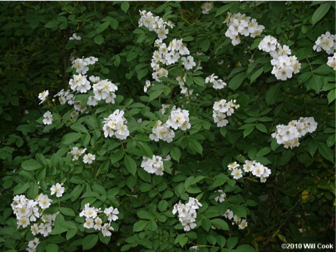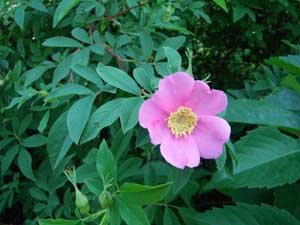

Multiflora Rose
Terry Bonace

On a sunny day in early June while driving along Highway 12 at about 45 miles per hour, you can easily pick out multiflora rose (Rosa multiflora). When it is in full bloom, with the elongated clusters of multiple white flowers growing in massive tangles of thorny brush, the multiflora rose stands out quite well. It is easy to see just how abundant multiflora rose is and in what large masses it can grow. Swink and Wilhelm in their book Plants of the Chicago Region (1994), written more than 20 years ago, described multiflora rose as “one of the most persistent and annoying weeds in the Chicago region. It thrives in almost every degraded terrestrial habitat…” A “degraded” is simply one in which some man-made disturbance, even quit minor, has taken place.
Multiflora rose was first introduced into the United States in the 1860s, brought from Asia to serve as root stock for ornamental roses like the hybrid tea roses so prized at Valentine's Day. Rootstocks are usually chosen from plants that will provide strong, healthy, disease resistant roots for grafting to a somewhat more tender above-ground plant of a closely related species. Later, in the 1930s, the Soil Conservation Service (the same party responsible for autumn olive) encouraged the use of multiflora rose for erosion control and as a “living fence.” A 1950 article from the U.S. Department of Agriculture extolls the virtues of multiflora rose: “Chief among these is the fact that it will make a living fence that will keep both your livestock and your soil within its boundaries. It is also the least expensive fence that you can establish and the cheapest to maintain. One thousand plants will give you 1,000 feet of living fence. Where fences of wire or wood do not shelter birds or rabbits, multiflora rose furnishes welcome cover for farm wildlife. As compared with the usual fence, a living fence of multiflora rose is a thing of lasting beauty…”
If you have ever tried to remove multiflora rose, you will well understand how eventually its persistent, spreading growth habit was found to be a problem. Multiflora rose is now regulated in at least 12 states, in several as a “noxious weed.” Indeed, Rosa multiflora gets its own section in Indiana's code , IC 14-24-12-5, which states that “a person may not plant any veriety of rosa multiflora in Indiana unless the person has a permit issued by the division director authorizing the planting of the variety of rosa multiflora.” Permits are to be granted only for controlled experiments. (Legally recognized nurseries may plan multiflora roses for grafting root stocks.) Multiflora rose rapidly outcompetes surrounding vegetation, forming dense thickets and smothering out native plants. The canes, which can grow as tall as 15 feet, send up new shoots when they come in contact with soil. A single plant can produce 500,000 or more seeds. These seeds, dispersed by birds, can remain viable for 10-20 years in the soil.

There are several native wild roses that grow in Beverly Shores but they are quite different from multiflora rose. The showiest of these is the Swamp rose Rosa palustris, that you can see throughout much of the summer along the edge of wet areas on Broadway and Beverly Drive. It is often tall and stands out well among the wetland vegetation with a showy, pink and very fragrant flower. Less showy but still common is the pasture rose or Carolina rose. This one grows in drier habitats lower to the ground and is also pink and fragrant. These two roses are worth the time to stop and smell. Multiflora rose grows in a wide range of habitats from full sun to nearly full shade and is distinguished from these other two native roses most easily by its elongated clusters of small white, flowers.
At certain stages, wild blackberry and black raspberry could be mistaken for multiflora rose because of their thorny, bramble like habit. The flowers are somewhat similar too, since the berries are in the rose family, but when the fruit appears, any doubts should be eliminated. The wild blackberry also has a powdery bloom on its stems that can be rubbed off.
Though one can find multiflora rose, particularly its seeds, for sale on the Internet, it is no longer planted in Beverly Shores. The main problem facing residents is to control or eliminate it. If you have the right equipment, like a strong mower, repeated cutting can keep multiflora rose under control. Stems should be cut at least once per growing season as close to ground level as possible. For large thickets of multiflora rose where risk to other species is minimal, spray the foliage with a glyphosate (“Roundup”) containing herbicide. Thoroughly wet all leaves. When you are concerned with neighboring plants, the best method is to cut the rose to stumps and to carefully treat the stumps with glyphosate. This last method can be used when the rose is dormant or growing. As always, when using herbicides and other pesticides, be sure to follow the label directions as required by state and federal law.
The Environmental Restoration Group (ERG) will be glad to help identify multiflora rose for you and make suggestions for native replacements. Don't hesitate to contact Terry Bonace (tbonace@gmail.com), Hans Lagoni (hlagoni@comcast.net ) or Bill Schaudt (blschaudt2@gmail.com) for assistance.